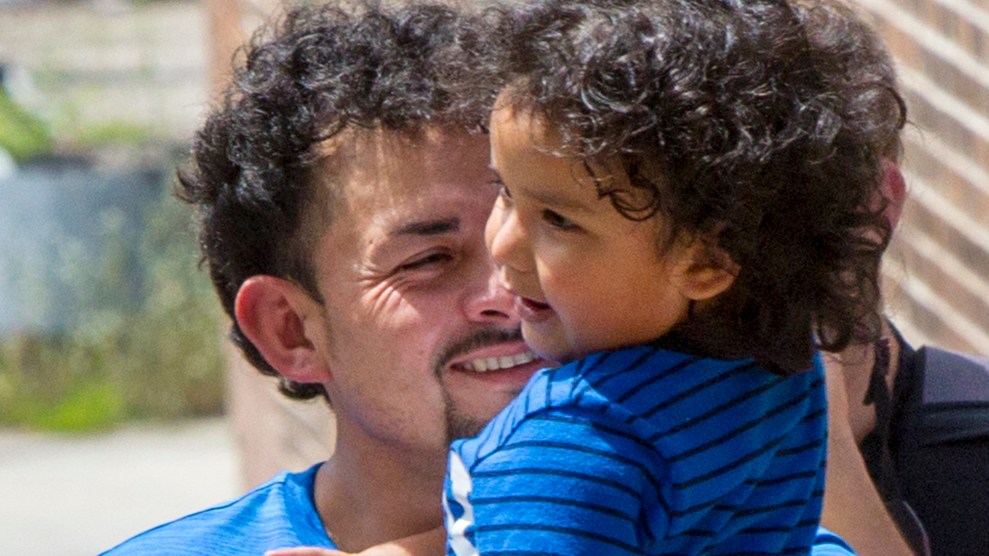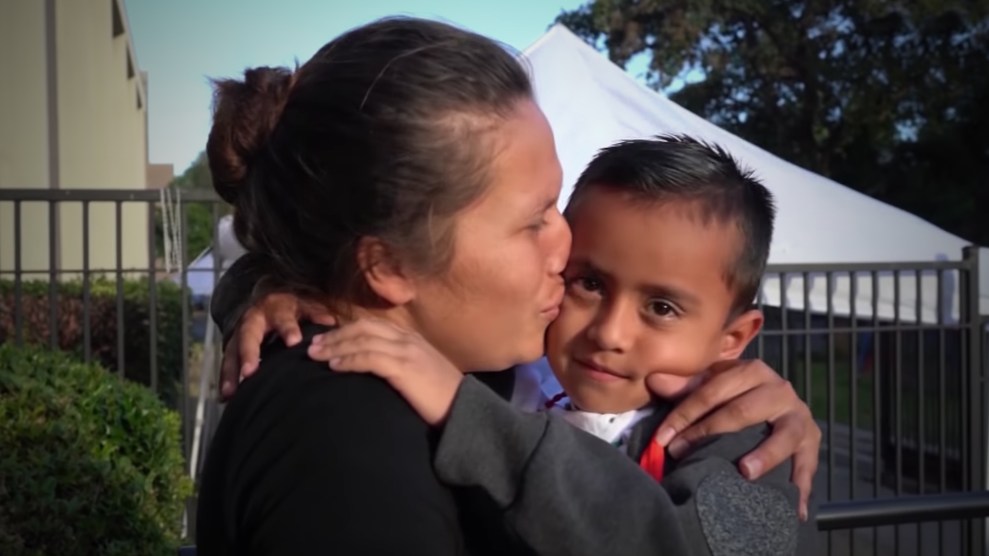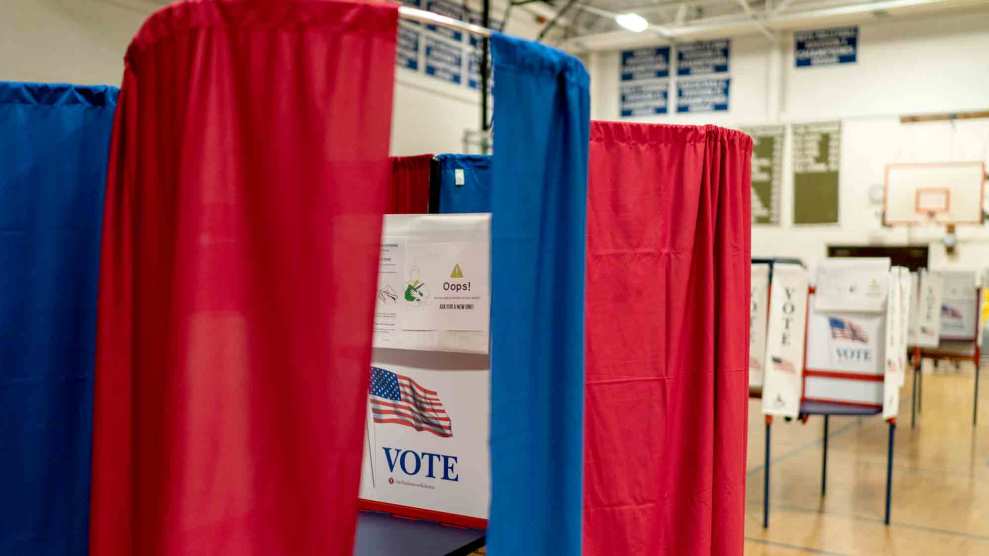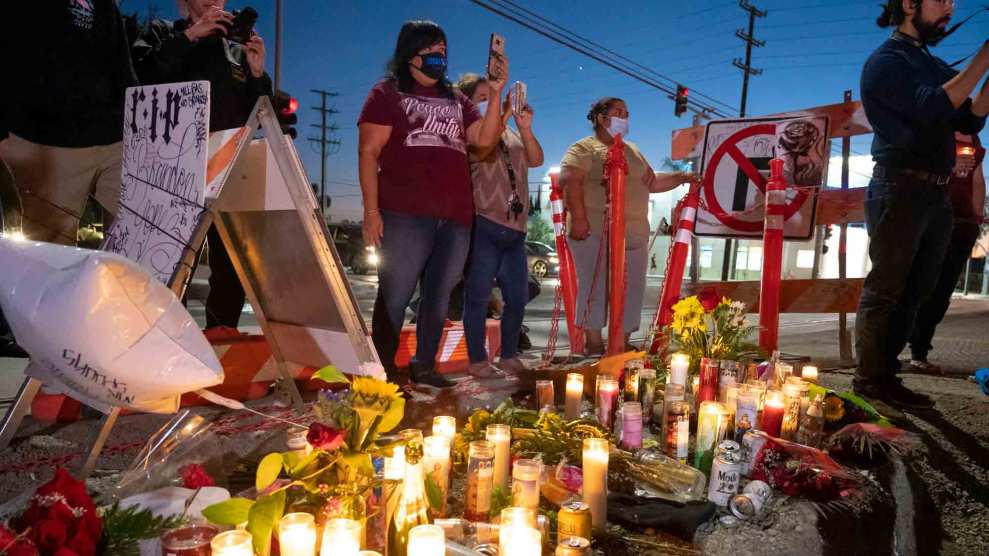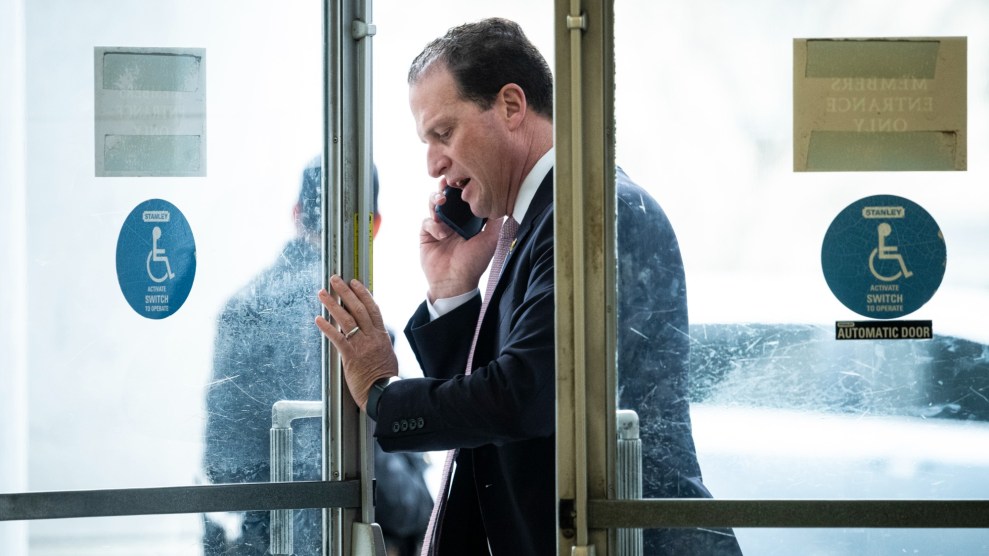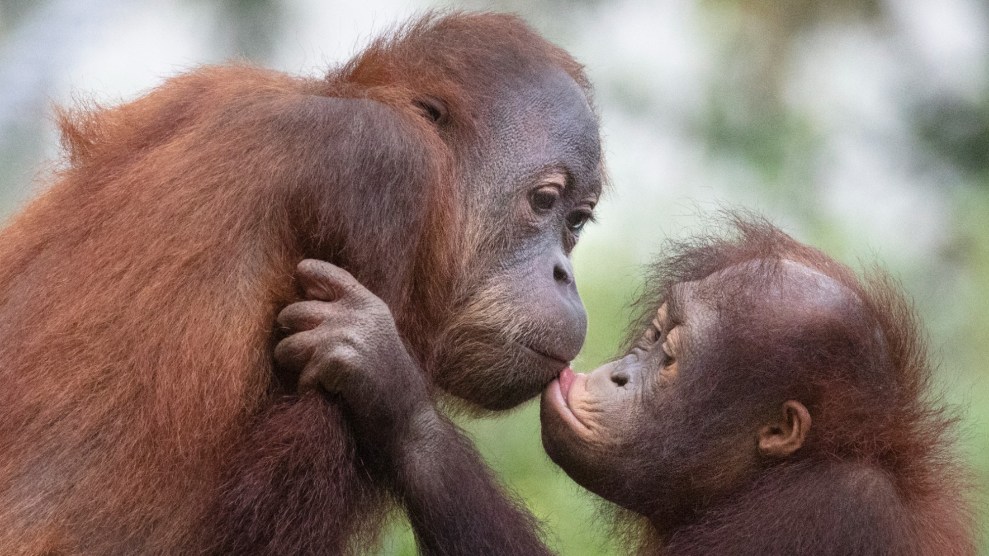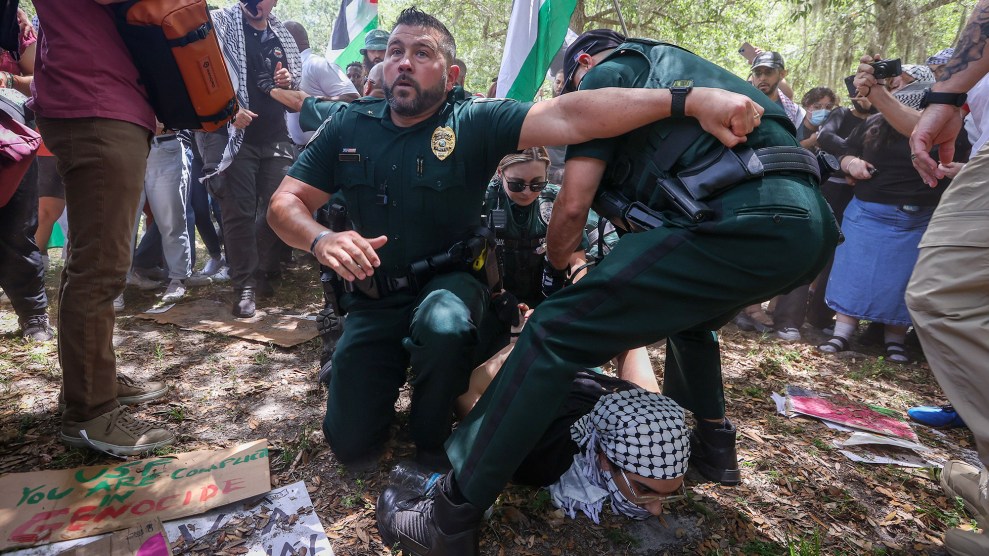
Getty Images
This story was originally published by ProPublica.
Sendy Karina Ferrera Amaya opened her mouth, and a gloved hand gave each cheek a perfunctory brush with a cotton swab.
Fifteen seconds, and the $429 DNA test she’d paid for was over. “Eso es todo,” the lab technician said last Thursday. That was it. Ferrera, 25, gave a tentative smile and walked out to join her fiancé. Squeezing his hand as they drove away, she allowed herself to hope. To imagine her curly-haired 1-year-old daughter wrapped in her arms, much bigger and more wiggly than last time she held her. Maybe next week, she would finally be reunited with Liah, whose name she wore around her neck like a talisman.
Even though the Trump administration is under a court order to reunite children who were separated from their parents under the “zero tolerance” immigration policy, Ferrera has no idea what that means for her family. Liah had traveled from Honduras with her uncle in mid-April. Ferrera was in the United States already, having entered undetected months earlier.
She has spent the three months since Liah was taken into U.S. custody trying to get her daughter released from foster care for unaccompanied immigrant children—doing her best to prove to the U.S. government that she is Liah’s mother, and a good one.
She spoke with ProPublica about that experience, allowing a reporter to accompany her to a DNA test and sharing three months of daily communications over WhatsApp with her caseworker which catalogue what have felt to her like a never-ending list of requirements she needs to meet to see her daughter again.
They shed light on the bureaucratic maze that families encounter when trying to retrieve a child from the immigrant foster system run by the Department of Health and Human Services—a place where the rights of foreign parents collide with U.S. officials’ stated desire to protect the interests of children whose backgrounds are unknown to them.
Ferrera’s daughter is one of 11,800 unaccompanied minors in HHS care, many of whom are older kids who traveled alone to reunite with relatives or family friends here. Officials would not say how many more, like Liah, are under 5, but last year almost 7,000 kids under 12 passed through HHS shelters.
Like Ferrera, many of the relatives and friends trying to claim these kids are undocumented, presenting a conflict in which they have to submit to extensive background checks from one arm of the government, HHS, knowing that another arm of the government, Immigration and Customs Enforcement, is combing the country to find and deport undocumented people. The fear of deportation has prompted some to avoid the process, leaving kids languishing in the system.
Ferrera was nervous about what could happen at first, but she knew this was the only way to get her daughter back. “If it’s my turn to leave, I’ll go,” Ferrera said. “But with my daughter. Not alone. And so I’m doing this for her.”
She has provided U.S. officials with her Honduran ID, birth certificates, passport, bank statements, proofs of address, fingerprints, extensive documentation for her fiancé, phone contacts and identification for family in Honduras, call logs of her past video calls with her daughter—even ultrasounds, doctors’ records and a photo of matching hospital bracelets from the day Liah was born.
So far, it hasn’t been enough.
HHS officials told ProPublica they would not comment on individual cases. Liah’s caseworkers did not respond to multiple interview requests.
In the past, HHS has come under fire for lax vetting standards: During a period in 2014 when the agency relaxed fingerprint requirements, eight teens were released to human traffickers and were forced to work in slave-like conditions on an egg farm. The agency has since beefed up requirements for reunification, and in recent weeks, HHS officials have defended the system, pointing out that stringent vetting is meant to ensure that children are kept safe.
“Our process may not be as quick as some might like, but there is no question that it is protecting children,” an HHS official said in a phone call with reporters last week. In the process of vetting the parents of 103 separated children under 5, the agency says it found 11 adults with serious criminal histories, one allegation of abuse, and one circumstance in which the adult planned to house a child with a pedophile.
After a judge found HHS was not reunifying separated families fast enough, HHS filed court papers Friday indicating it will loosen its vetting restrictions for the parents of children who fall under the court order.
To Ferrera, the process has felt maddeningly opaque. Each day that passes without an approval gives her a sick, sinking feeling. She has kept up a constant stream of WhatsApp messages to Liah’s caseworker, an employee for Southwest Key, the largest licensed nonprofit shelter provider for unaccompanied children who cross the border.
April 30: How is my daughter?… Do you think they’ll let you send me a photo? It’s been days since I’ve seen her…
May 14: Are we failing at something?… I’m sorry to insist so much but it seems like they aren’t going to give me my child and I feel so desperate, hasn’t the lady from the government given you a response?
May 30: Please, I ask you to help so they give me my baby. I feel that I will die if they do not… It’s unjust, I am her mother.
Sometimes the caseworker responded with mild placations. Other times, days passed without a response. She reminded Ferrera that resolving Liah’s case wasn’t up to her. She was beholden to a señora del gobierno—a government lady—to approve the reunification. And the señora seemed to always have another question or demand.
Ferrera’s fears continue to grow that the government will deem her unfit to receive her child and instead allow Liah to be adopted by someone else.
HHS officials sent ProPublica a general statement about this, saying, “(The) first preference, consistent with federal law, is to release the child to their parent or legal guardian…Reunification is the ultimate goal…and we are working toward that for those unaccompanied alien children currently in our custody.”
Ferrera has read the comments on articles about mothers who took their children on the dangerous journey to cross the American border.
“They say, ‘Why did you leave your country? You know that you can’t stay here because you are illegal.’ They judge you,” she said. “And maybe in this interview, and when you write this report, more people will judge me.”
Despite the potential for “cruel comments” and threat of deportation, she said she wanted ProPublica to tell her story. “While there are some people who criticize,” she said, “there are other people who understand.”
Liah was only two months old when Ferrera headed north with a smuggler, the wound from her C-section still healing. She hated leaving her newborn in her brother’s care, but felt she couldn’t wait any longer.
Liah’s father had turned aggressive when Ferrera told him she was pregnant, revealing he already had a family of his own, she said. He would show up at her house making threats, relatives recalled. Her 16-year-old cousin remembered him appearing one day when the two were alone and Ferrera was pregnant. “He said it would be best to abort Liah,” said Fany Noelia Funes Zaldivar. “I was crying because I did not know how to defend her, and he wanted to punch her in the stomach.”
While Ferrera was pregnant, a friend introduced her to Juan Barrera Bucio online. A Mexican citizen, he had been living undocumented in the U.S. for 15 years and seemed to be doing well. He had steady work, a kind, calm demeanor, and had already raised two children of his own. They struck up a correspondence and fell in love. Ferrera realized she didn’t have much left for her in Honduras. Her job in construction paid little and was going nowhere. The streets of Olancho, her hometown, were filled with gangs and police who could beat anyone with impunity. “When someone else depends on you, then you start to think of your future, what you’ll offer,” she said. “I didn’t have anything to offer.”
Barrera, and America, had something to offer.
Her family agreed she should go and send for Liah later, when the infant was big enough to stand the grueling weekslong journey through Guatemala and Mexico. Ferrera left with smugglers in late June 2017, having paid $5,000, and entered the U.S. undetected a month later. Barrera, who recently obtained a special employment visa for helping the police catch a criminal, has supported her since she arrived, helping her find work, teaching her bits of English, and introducing her to his favorite chicken marsala dish at Olive Garden.
After Liah began taking her first steps, Ferrera decided it was time for her brother to bring her to the U.S. He sold many of his belongings to pay smugglers $5,000, but Ferrera said he saw it as an investment; if things went well, he could expect to stay with Ferrera and Barrera for a few years to work and save money.
Uncle and niece set out on April 5.
Liah was remarkably calm on the difficult journey, said Ferrera’s brother, Alexander Antonio Ferrera Amaya. They rode in the pitch-black darkness of trailer beds and crossed a river in a rubber boat. When they traveled through the desert for two days, she stayed tucked in his arms and almost never cried. If she began to fuss, he handed her a cookie from his supplies.
On April 14, they crossed the Rio Grande into Texas. The next day, Border Patrol caught them and took them to a detention center. Two days later, Ferrera’s brother’s name was called from a list, but not Liah’s. An agent came for the child. “When they took her from me, she cried,” Ferrera’s brother said. “She wanted to stay with me, and with no one else.” The agent didn’t explain where he was taking her.
The family had hoped that Ferrera’s brother and Liah would be guided by the smugglers and escape detection by immigration authorities. But even if they did get apprehended, they had reason to believe they’d be kept together and allowed to mount an asylum case. They had heard of cases in which young children who couldn’t speak were kept with relatives in family detention centers and then released. “We thought that since she was too small, they would let him stay with her until they brought her to us,” Ferrera said. “But no, they separated her.” Ferrera’s brother was deported three weeks later.
Ferrera and Barrera had planned a celebration with friends on April 21, expecting Liah would arrive by then. That day, Ferrera remained optimistic, thinking a reunion wouldn’t take longer than a month, telling everyone she knew that soon she’d have her baby back. They cooked carne asada. Friends brought gifts for the baby.
Now, Ferrera runs her fingers across those frilly shorts, dresses and onesies, and wonders if Liah will be too big to fit in them by the time they are reunited. Or, a more frightening thought—whether that reunion will happen at all.
The day she was taken from her uncle was Liah’s first birthday. Ferrera was notified the same day by a Southwest Key caseworker that the baby was in their care.
At first, Ferrera was relieved, glad to know Liah was safe and sure she would see her soon. The caseworker seemed businesslike, but also sympathetic. She sent Ferrera a manual and video about reunification, a list of documents she would need to provide, and a warning about potential scammers who target families of unaccompanied minors. She told Ferrera to start saving for the plane tickets for Liah and a government-contracted caretaker, who would fly with her. After Ferrera asked, the caseworker sent a photo of Liah in a high chair, wearing a bib. She was eating a banana, the caseworker said.
Messages show Ferrera begged the caseworker, almost daily, to schedule video calls. Do you think they’ll let me see her on a video call I miss her so much, she texted on May 15. When Liah was still in Honduras, Ferrera would call her sometimes three times a day. The caseworker told her it couldn’t become a weekly thing—her supervisor had to approve it every time.
When they did take place, the calls, while reassuring her of her daughter’s well-being, reminded Ferrera of what she did not know. She was told Liah was in foster care in Texas, but was not permitted to know where, exactly. Liah usually appeared in a nondescript office surrounded by computers, desks and papers. The video framed her tightly, as if she was inside a miniature painting. There were never any other children around, and the workers who accompanied Liah would not respond to questions. What was Liah eating? When does she sleep?, Ferrera tried to ask. But they were silent and only interacted with Liah, who, as time went on, became increasingly distracted during the calls.
All the while, Ferrera was sending the caseworker any shred of paper that could establish her identity as Liah’s mother and show she had a stable life.
“In the past, a parent who comes forward was almost certain to get cleared quickly (unless there was some valid concern the parent would put the child at risk),” said Greg Chen, a director at the American Immigration Lawyers Association. “But the new administration has erected all sorts of barriers blocking these children from release into these safe family settings. Even worse, ICE has begun targeting undocumented parents and guardians who have been living in the country and who come forward to take custody.”
The growing relationship between ICE and HHS under the Trump administration has alarmed advocates, who have accused the government of using kids as “bait” to get information about undocumented people in the U.S.
Ferrera shared her personal data with HHS at a moment when the Trump administration was preparing to further expand its information-sharing capabilities between the agency and ICE. On May 8, the Department of Homeland Security detailed changes to a system that allows ICE access to records of people seeking to claim children in HHS care.
The purpose, the public notice said, was partly to check their immigration history “and to identify and arrest those who may be subject to removal.”
But Ferrera’s largest fear remained that they wouldn’t give Liah back at all.
Do you think they will say something to me because we live in a trailer? Ferrera fretted to the caseworker on May 16. There are parks nearby, schools, clinics, shops…
And the trailer is in good condition. It’s really clean and the baby’s room has everything that it needs.
The first home visit happened in May. The woman told Ferrera and her fiancé they shouldn’t be worried, Ferrera said. This would be fast and was just a basic requirement. They welcomed her into their tidy trailer, painted white with green trim, with a porch swing out front. They showed her the baby’s pink-accented nursery, filled with toys and a crib with Peppa Pig sheets. She asked about their habits, their schedules, their experience with children. Did they have any guns?
Then, Ferrera says she was told the report came back pointing out some issues: The crib wasn’t big enough. They needed a car seat. Ferrera didn’t have an independent income or any way to get around.
To Ferrera and her fiancé, the questions and new requirements seemed arbitrary, increasingly absurd, and even contradictory.
For example, Ferrera had been working a cleaning job when Liah first arrived, but this became a concern. In a phone call, Ferrera said she was asked, how she would reconnect with her child if she was working. Wouldn’t she need time to bond?
So Ferrera quit.
But at the home visit, a new caseworker asked why she didn’t have a job, Ferrera said. Even though they knew she didn’t have a legal work permit, what if she needed to break up with her fiancé?
So she became a babysitter, taking care of three children for $90 a day. She submitted evidence of a separate bank account and the names and IDs of people nearby who she could rely on in case of an emergency.
The caseworkers were also worried she couldn’t drive—what if there was an emergency? They knew she didn’t have a license. Ferrera said she knew how to call Uber and had a friend nearby who could drive her around. Barrera began to teach her after work, practicing turns in parking lots nearby.
On May 31, her caseworker told her she should go to a class run by Women, Infants and Children, which provides federal grants for low-income mothers with children under 5 who are at nutritional risk.
Ferrera looked up the program and expressed her doubts. Barrera was making good money at $28 an hour as an industrial painter, plus overtime now that he had a legal work permit. And she was also earning steadily. Is this obligatory? … It says this is a program for mothers of low economic resources, and so I don’t think I need it, she wrote to the caseworker. We don’t need the government. We can take care of her perfectly. I don’t understand.
But the caseworker appeared to believe parenting classes would bolster her case to her supervisor. I just want to put more appointments so that they can see that in reality you are doing the most possible to get your daughter back, the worker wrote. She pressed the mother to arrange one at a local parish and document it with photos. But when Ferrera showed up, she was told there were only classes in English. She said she would manage by bringing a friend with her to translate.
The caseworker asked for his information too. I want to put it in the file, she said.
Then, Ferrera said, she asked her why she was not taking English classes.
At the second home visit in June, the caseworker asked how Liah would relate to them after they had been separated for such a long time. “I said, ‘I don’t know. I will do everything I can so she gets used to me, and have patience for her because she’s my daughter and I’m her mom,'” Ferrera said. The caseworker said she needed to look for a place to take classes as a parent. So she and Barrera got a family therapist, paying $70 per session each week. She submitted the confirmation receipts to her caseworker.
Trying to find new ways to strengthen her case, Ferrera sometimes sent side-by-side pictures of Liah and herself as a baby, both cherub-faced with a mop of curly hair. She looks just the same as her mom when she was a baby, Ferrera said. At the end of May, Ferrera practically begged to take a DNA test if it would speed up the process. She heard no response.
Ferrera and her fiancé started getting seriously nervous at the end of June as it became clear that the administration was using family separation on the border as a deterrent. Barrera read articles saying immigrants were being told to surrender to deportation in order to get their kids back. Was Liah going to be used as a bargaining chip to make Ferrera return to Honduras? Friends speculated the authorities might be comparing Ferrera and Barrera to other prospective parents, deciding who was in the best interest of the child.
On June 29, the social worker texted she had “received very good news” from the second home visit. She would turn in the case next week.
Another week passed.
You still didn’t receive a response about Liah’s case? Ferrera wrote on July 9.
Yes I received an approval but now I am waiting for a second, she replied. I need two, I only have one for now.
Then on July 12, Ferrera got a sudden notification. She would need to take a DNA test the very next day. She felt blindsided.
What were all the interviews for and the runaround if, since the beginning, they could have done this [DNA test]? she texted the caseworker. Now, I’ll have to wait for more time to reunify with my baby. It’s like everything that we have done was in vain and didn’t serve anything, I feel totally offended. Barrera took the day off from work to drive her to get the DNA test last week.
Now, she prays and leans on Barrera’s words of comfort that everything will work out. The couple tries to focus on the best case scenario: That Liah will be returned, and her court case will go well—though the Trump administration has made it close to impossible to receive asylum based on domestic violence. Maybe, one day, Barrera can turn his U visa into a green card. Maybe then, once he marries Ferrera, he can help her get legal status and unite their family.
But that would be four or five years in the future. In the meantime, the deportation machine has revved up, and all of Ferrera’s information, down to her address and DNA, is in the government’s hands.
In the worst moments, Ferrera says she remembers the day Liah was born. “She was crying. Then, when she got near me, she became quiet. She stopped crying,” Ferrera said. “And then I realized that she knew that I was her mama and that she was with me and that she felt secure and protected. And this is what helped me keep going forward, to keep protecting her, always, keep going.”
